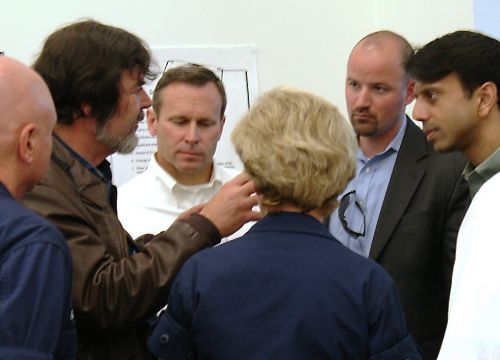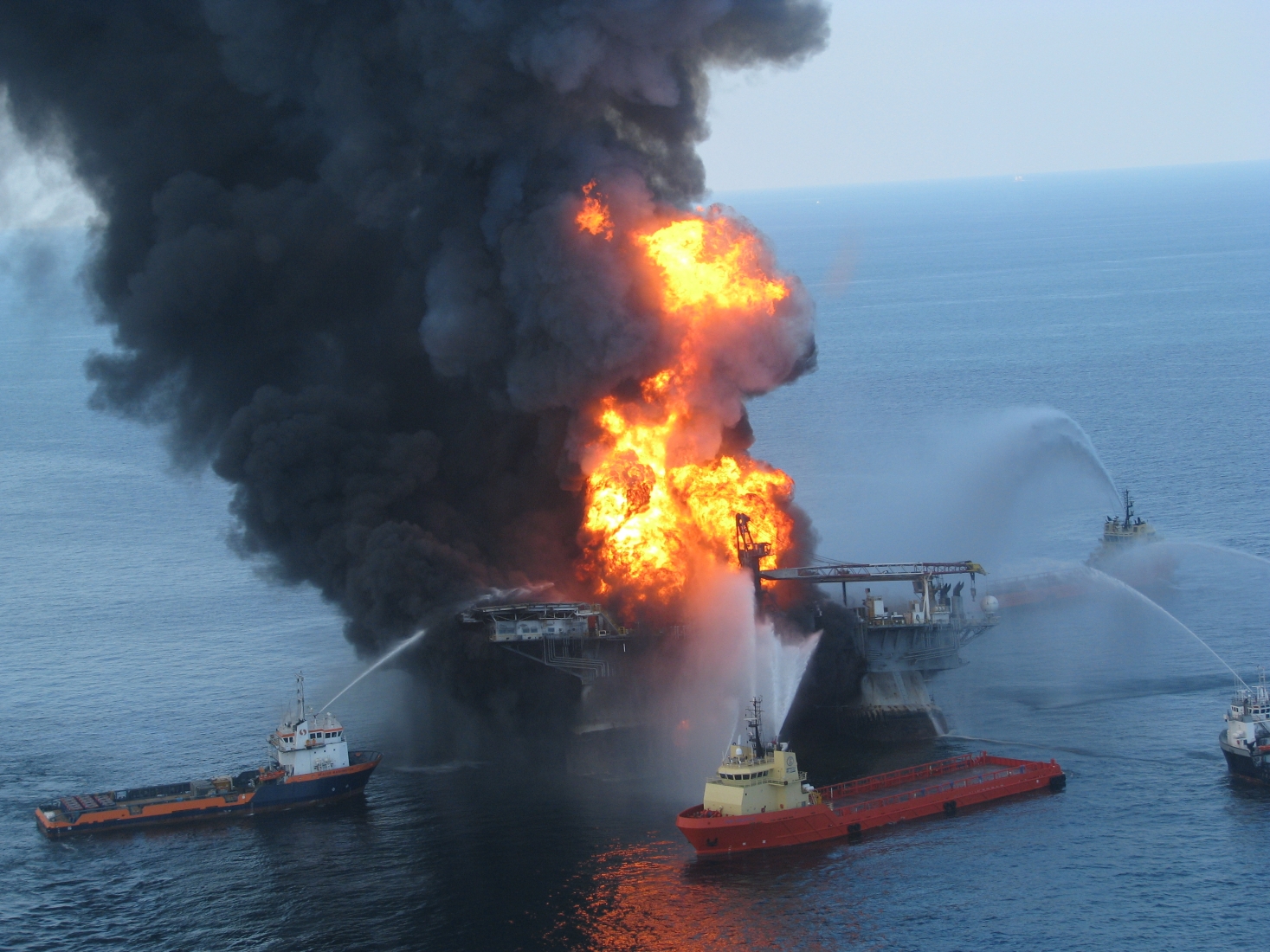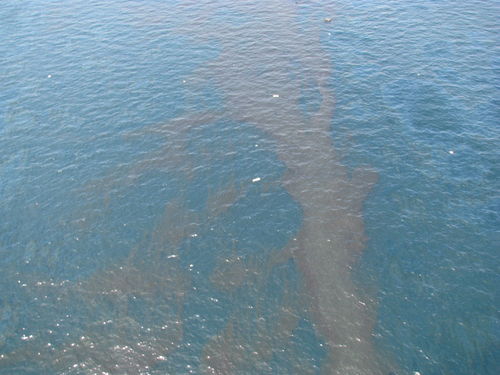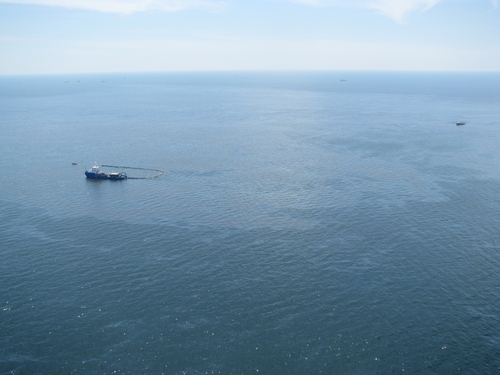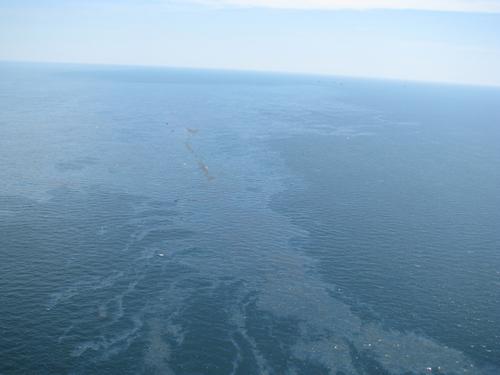On April 20, 2020, NOAA will join our state and federal partners in observing 10 years after the Deepwater Horizon oil spill — an incident that resulted in the tragic loss of human life and an unprecedented impact to the Gulf’s coastal resources and the people who depend on them. From March 30 to April 20, tune in as we go back in time to the day of our country’s largest marine oil spill, what’s happened since then, and how we’re better prepared for future spills. In our latest blog, get a detailed look at the early hours and days of the spill.
1:24 a.m. Wednesday, April 21, 2010 — Baton Rouge, Louisiana
Not long after midnight, the phone rings. It wasn’t unusual for Charlie Henry to be woken up in this fashion. As a scientific support coordinator for NOAA’s Office of Response and Restoration, he often receives calls at odd hours — being woken up sometimes as often as a couple times a week for incidents ranging from sunken vessels to pipeline discharges.
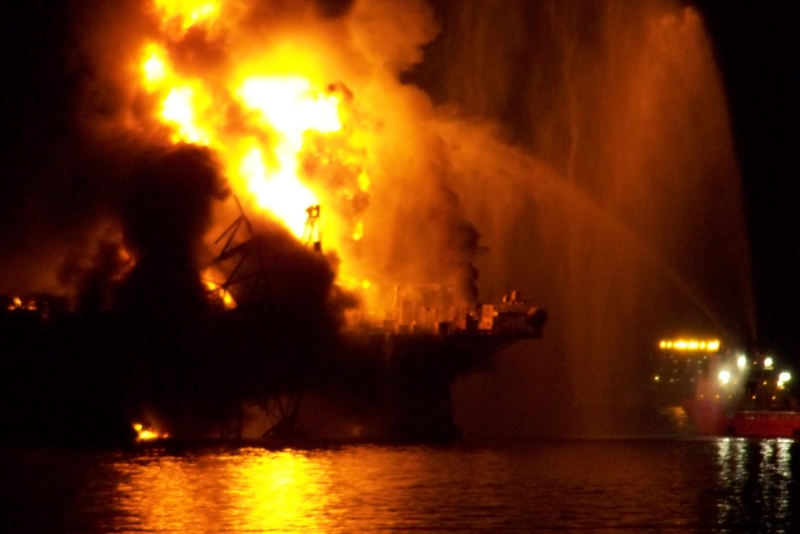
The voice on the other end usually belongs to a U.S. Coast Guard duty officer, and tonight is no different. This time the young man on the line is calling to tell him there was an explosion on an oil rig about 50 miles off the coast of Louisiana in the Gulf of Mexico just before 10 p.m. that night, April 20.
“All we know is there’s a report of fire, and everything right now is focused on search and recovery of the crew,” he said. “We still don’t know why there’s a fire, the only thing that we could see would cause it is the diesel fuel.”
No one was certain what had happened. The first priority was to rescue the crew still aboard the rig — 126 in total. Charlie woke up Glen Watabayashi, the lead oceanographer with OR&R’s spill modeling team in Seattle. No matter what was the actual pollution being released, the ocean currents and winds would still control the transport. Getting ahead on the current oceanographic condition might also help support the search and rescue effort.
4:00 a.m. — Morgan City, Louisiana
As Charlie arrives at the Coast Guard’s command center in Morgan City, he’s briefed again on the status of the incident. More than half the crew have been rescued. Some of the early photographic images that began to arrive by email at the command center showed a huge plume of fire, but not much else. It was unlikely that this was a diesel fire, but nobody knew what had really happened.
5 a.m. (approx.) — Seattle
In Seattle, Doug Helton was at home just starting his day when he received his first call regarding Deepwater Horizon. The situation was still focused on search and rescue efforts, but they also knew that about 700,000 gallons of diesel fuel was aboard the rig at the time of the explosion.
Members of the Seattle team begin trickling into the office’s ‘war room’ — a room used for meetings, but also designated as a point of coordination during an incident response. As the incident operations coordinator, Doug is the one working the war room — pulling together the facts and moving staff into place like pieces in a puzzle.
Among the first activated for the incident were oceanographers Amy MacFadyen and Chris Barker, who began running trajectories for both the missing crew and the possible oil discharge.
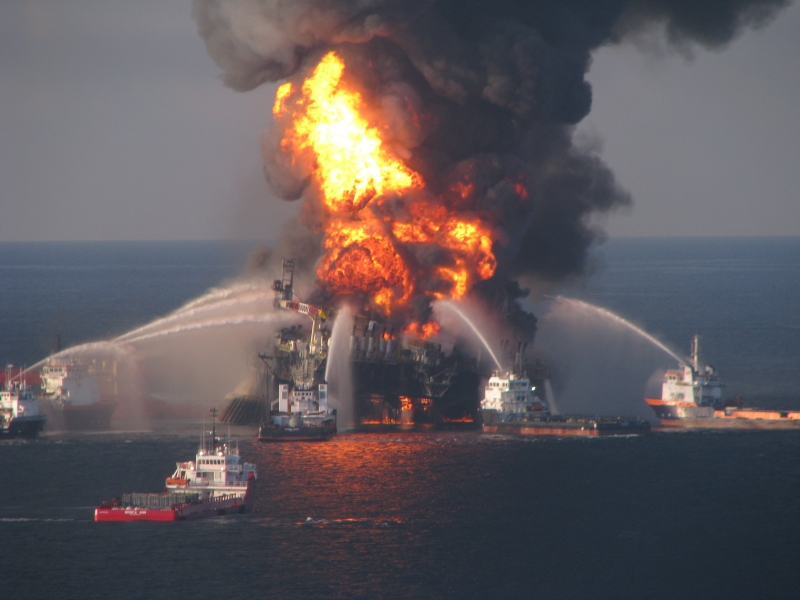
Deepwater Horizon April 21, 2010. Note list of platform. Image credit: U.S. Coast Guard.
7:36 a.m. — New Orleans/ Morgan City
In the first official press release from the U.S. Coast Guard, the remaining number of missing crew members has dwindled down to 11-12 people. According to the release, the other crew members were safely rescued, with seven critical injuries reported.
The fire is still burning, and the cause of the fire remains under investigation as the Coast Guard continues to respond by air and water.
As daylight breaks, bringing with it a clearer picture of the situation, responders begin to recognize that something bigger is going on. The pollution concern appears to be greater than the 700,000 gallons aboard the oil rig. Though not many overflights have been conducted at this point — as resources are otherwise devoted to the search and rescue efforts — the unfolding situation, like the details of a polaroid photo starting to emerge, begins to tell the story of a much bigger problem looming beneath the surface.
“It wasn’t hard to look at pictures from the field to figure out that you had a wild well situation,” Charlie said.
Though the response efforts are still focused on search and rescue, responders begin planning for a worst-case scenario wellhead discharge.
Noon — Seattle
Back in the war room, Doug Helton is coordinating with the team in Louisiana as he continues to assess the situation and determine who to send on scene to support Charlie and the incident command. Mary Gill, an assistant scientific support coordinator, is on scene at the BP command post in Houston, while others are preparing to mobilize.
Seattle’s support team, including an overflight specialist and an information management person, remains on standby. Trajectories are being run under the possibility of a continuous wellhead release, and a resources-at-risk summary is being prepared for the offshore area of the Gulf of Mexico. At this time, shoreline impacts are not anticipated.
As the fire burns on, it is unknown how much oil is being released or how much is being burned up in the fire.
8 p.m. — New Orleans/Morgan City
At the end of a long day that began more than 15 hours ago, Charlie writes his evening report — giving a status update, touching on the events of the day, and addressing the concerns of tomorrow.
“The Deepwater Horizon is on fire and continues to burn,” he wrote, “and the vessel (a very large semisubmersible) is reported listing roughly 15 degrees and is severely damaged to the point that the stability of the vessel has been questioned.”
Charlie went on to say that firefighting efforts had scaled back, as responders feared the force of the water was contributing to the vessel’s increasing instability. The primary response priority, he said, was still the effort to save the 11 crew members still missing. At the time of his report, responders were operating under the knowledge that there was, in fact, a wild well release.
“The volume or rate of the release is unknown, but thought to be significant,” he wrote, “I would not be surprised if that value is in the 10,000 to 20,0000 barrels (420,000 to 840,000 gallons) a day range … a best guess estimate based only on past experiences.”
The oil was continuing to burn at the platform, generating 300- to 400-foot flames, intense heat, and black smoke. NOAA’s updated trajectory analysis that day found that a significant release of oil could pose a risk to the Northern Gulf of Mexico — though it would take several days for oil to threaten the shorelines. BP, the responsible party, had already mobilized a range of on-water pollution response vessels earlier that day, though environmental response efforts were expected to ramp up the following day.
BP was also working to attempt a shut-in of the well at the seafloor using a remotely operated vehicle (ROV) to activate the blowout prevention system. Two attempts early in the evening failed, though a third attempt was scheduled for later that night.
“Controlling the source of the release is the most important operation outside of the search-and-rescue effort,” Charlie wrote. “Should the semisubmersible sink or detach from the riser, it is likely that the fire mitigation would be lost. A major oil spill would be the expected result.”
Charlie noted that failure to shut the well in would result in a weeks-long continued release until a relief well could be drilled. He added that if the well was not secured that night, NOAA’s on-scene presence would likely ramp up to be in a better response posture in advance of a major release.
9:30 a.m. Thursday, April 22 — Morgan City
In his first report on Thursday morning, Charlie notes that the rig is still on fire and that the third attempt to shut-in the well failed the previous night. Attempts to make the blowout prevention device operate to mitigate the release are still underway.
With more resources being allocated to the environmental concerns, the Coast Guard works to set up a unified command closer to the incident — most likely in Houma, Louisiana.
Charlie notes in his report that some weather is approaching, and reiterates his concerns from last night’s report, stating that “unless the source is secured, the threat of a major oil spill is very real.”
10:30 a.m. — Morgan City
During a meeting with BP, the U.S. Coast Guard, and the many other responders involved, the discussion is focused on what to do to prevent a bigger pollution incident. Live video feed in the room showed the semi-submersible listing to its side.
“This big ship is being tethered to the bottom by this thin line, and that’s all that’s holding it in place,” Charlie said. “We were sitting there talking about what to do and someone said ‘Hey, it’s sinking.’ It was kind of like that image of the Titanic. No one said anything. We just sat there and watched it. It took five minutes to sink.”
After sinking to the sea floor in about 5,000 feet of water, the silt and mud kicked up by the rig reduced visibility to almost nothing. While waiting for the water to clear, responders began a plan of action to start at the only known location they had — the wellhead.
An Explosive Beginning Filled with Unknowns
On Friday, April 23, 2010, the search and rescue efforts were suspended and the 11 crew members still missing were presumed dead. After the drilling rig sank and the mud had settled, all efforts were focused on containing the well — a task that would take 87 days to complete.
What was unique about the Deepwater incident, Charlie said, was the timing of the blowout.
“Usually when you have a well blowout, it happens during the drilling phase when you have a lot of unknown factors. This was a new well that was undergoing a temporary plug and abandonment for future production,” Charlie said. “What we learned later was that they had some failures in the cement work.”
In the early hours of the spill, it wasn’t immediately apparent that there was a wild well. When looking for a source of the explosion and ongoing fire on the drilling rig, responders looked to the more immediate fuel source of the 700,000 gallons aboard the rig. But within the first day, as the fire raged on, it was clear that something else was contributing to the flames and the oil in the water.
“By mid-morning [April 21], we came to the conclusion eventually that the people who really knew what happened probably died in the explosion. It took a long time to start piecing it together,” Charlie said.
In that first week of the spill, responders continuously worked to troubleshoot and trigger the blowout preventer and shut-in the well. Early pollution mitigation efforts were rapidly underway, though Charlie says, “We always held onto the hope through those first four days that the technology would save us. And it didn’t. The technology failed.”
In the decade since Deepwater Horizon, Charlie has talked about the incident and his experience as the lead scientific support coordinator to the spill at various conferences, workshops, and other events. In his presentations, Charlie emphasizes the lack of knowledge that they had in those first few days.
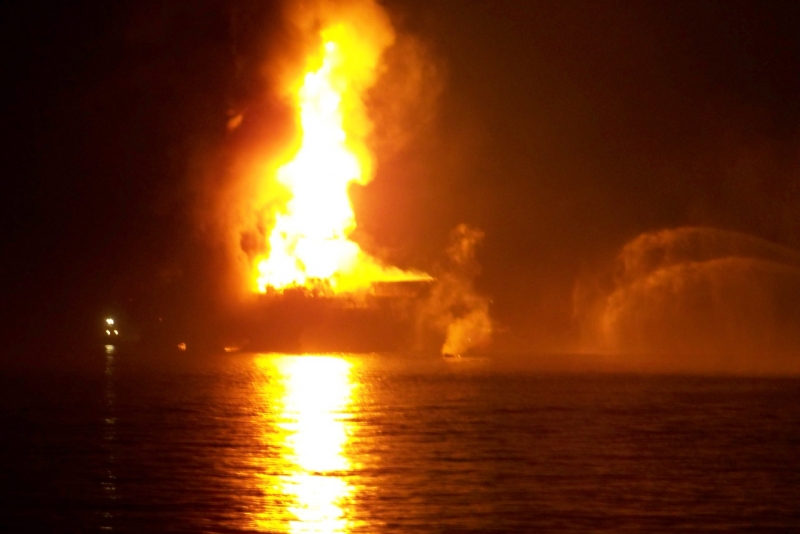
The first slide of his presentation is often black, as he says “that’s how much I knew when I got the call in the middle of the night.”
In the second slide, he shows a dark, blurry image of the rig on fire taken from a distance on a cellphone, and he adds:
“That’s how much we knew at 3 a.m. The clarity of the information was about the same as this picture. It looked like just a match — a flame in the night. And that’s how it grew, from total mystery to slowly getting knowledge about what was going on.”

